Show:
This article was updated in November 2024.
Trade has long ago moved from offline world to eCommerce and many of us have either heard of, or used services of the following companies. When COVID-19 occurred, this switch to online trading only enhanced. The largest eCommerce companies became even larger, as a result of meeting their customers’ needs.

Now, one might think that he or she knows all the companies listed, but only the giants have caught your eye since there are many more eCommerce companies whose net worth and revenues are measured in billions. They are not all Western; and no, Alibaba is not the only Chinese success story:
Not surprisingly, we start the list of the largest eCommerce companies in the world with Amazon and its empire. Amazon really is the king of eCommerce!

Founded in 1994 in Seattle by now immortal Jeff Bezos, Amazon has in the years since become a household name when it comes to online shopping. This internet company today has the largest revenue in the world, but its beginnings were humble. It was initially not more than an online bookstore.
Take a look at this very interesting interview with Jeff Bezos from 1999 and see how unpredictable things were back then.
Amazon was diversifying the scope of products it sold online in the following years. Who says books aren’t profitable!
Bezos can recall the title of the actual first book he sold from his garage in July 1995: Fluid Concepts & Creative Analogies: Computer Models of the Fundamental Mechanisms of Thought.
Amazon’s Market capitalization: $1,845 B (in 2024)
Amazon’s Revenue: $574,79 B (in 2023)
Amazon’s Number of employees: 1,521,000 (in 2024)
Many of us living in a western world didn’t even heard of this eCommerce giant! The second on our list of the largest eCommerce companies in the world is Jingdong, also known as JD.com
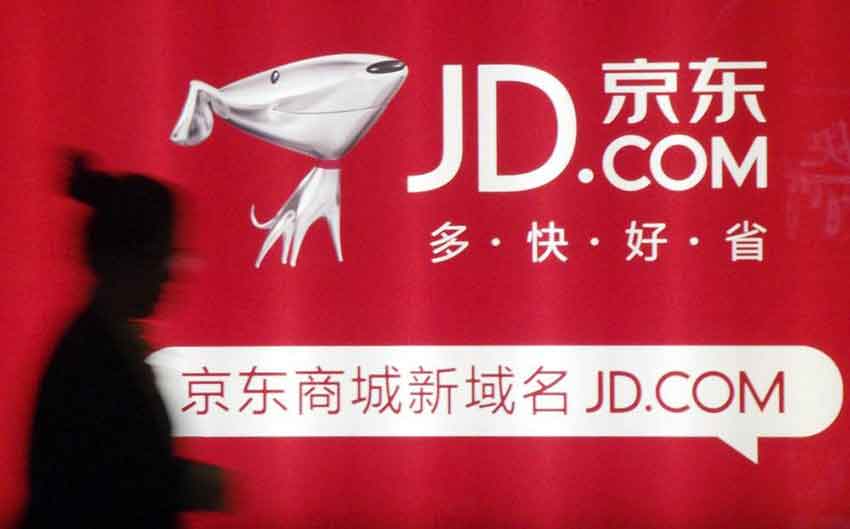
This eCommerce company operating from Beijing is the first of three major Chinese companies we list here. Rivaled by the more popular Alibaba, Jingdong has well over quarter of a billion registered users as of 2018. It was founded in 1998 and started trading online six years later. Today, the company brandishes its high tech delivery system, comprised of robots, AI, and a fleet of drones.
Now, if we measure market capitalization, JD.com is smaller than Alibaba. However, if we benchmark it by the revenue in last year, JD.com had about $20B more. If we are comparing the number of employees, JD.com has over 450,000 while Alibaba currently has a little over 235,000.
Jingdong are so tech crazy, they have plans to build drone airports, flight training and even flight control for drones who deliver goods. They have teamed up with scientists to design drones that could carry freights weighing up to one metric ton!
Jingdong’s Market capitalization: $45.74 B (in 2024)
Jingdong’s Revenue: $152.8 B (in 2023)
Jingdong’s Number of employees: 450,679 (in 2022)
If you are buying stuff on the Internet, there’s a significant chance that you bought something from AliExpress or Alibaba. This Chinese mega company comes third on the list of the largest eCommerce companies in the world!

Few people haven’t heard of Jack Ma’s success story. The Chinese business magnate’s life is a riches-to-rags story. Having been rejected from more than 30 job posts in the early 1990s, he started making websites for companies with his wife and a friend. The business grew exponentially and in the year 1999, Alibaba Group was founded, the world’s largest retailer of present-day, operating in more than 200 countries.
Jack Ma once asked a random waitress in a San Francisco bar what’s her first association to the name Ali Baba, and she replied: “Open Sesame.” Ma saw it as a perfect symbol of the opportunities and jobs his company could open for small businesses. Plus, it’s catchy, easy to pronounce and known across the world.
Alibaba‘s Market capitalization: $189.44 B (in 2024)
Alibaba‘s Revenue: $131.22 B (in 2023)
Alibaba‘s Number of employees: 235,216 (in 2023)

Founded in Beijing in 2010, Meituan grew into a localized shopping platform where the Chinese can find consumer products from their region of the country. Most of the products and services fall under the dining, entertainment, delivery, and travel categories.
As of 2015, the company expanded its business and became one of the leading online shopping companies, by allowing users to review restaurants, offering them group discounts and vouchers as well.
The secret behind Meituan’s vast user base of more than 300 million monthly active users can be found in over 400,000 partnering agreements with Chinese local businesses.
Meituan’s Market capitalization: $86.37 B (in 2024)
Meituan’s Revenue: $37.29 B (in 2023)
Meituan’s Number of employees: 114,731 (in 2024)

Many of us haven’t heard of this company until recently, even though it has been existing for over a decade. Shein is a worldwide fashion and lifestyle clothing e-retailer. The company was founded in 2008 in China. Currently, they are employing over 15.000 people and distributing to basically every country in the world. Over a short period of time, Shein became one of the biggest online shopping companies, with their app being the most downloaded shopping app in the United States, overthrowing Amazon.
Shein gained its popularity thanks to TikTok, due to a popular TikTok trend, which consisted of people buying and promoting clothes as part of their video. Check out one of many Shein haul videos below.
Shein’s Market capitalization: $63.70 B (in 2024)
Shein’s Revenue: $30 B (in 2022)
Shein’s Number of employees: over 15,000

Surprisingly enough, this is the first European company on the list of the largest eCommerce companies in the world.
Headquartered in Hamburg, the Otto Group has mastered mail order and retail eCommerce. They run nearly 60 subsidiary companies in more than 20 countries. Some of their more famous brands are the French 3 Suisses and the British Freemans. For more than half a decade, the Otto Group has been expanding its business into financial services and real estate.
The Otto’s family business is among the oldest on our list, as it was founded back in 1949. The very first catalogue they produced offered 28 styles of shoes. The online shopping website that made the group world-famous was launched in 1995.
Otto Group’s Market capitalization: $2.30 B (in 2024)
Otto Group’s Revenue: $16.19 B (in 2023)
Otto Group’s Number of employees: 38,500

What started as an air-conditioner retail store in 1990, is now one of the largest retailers in China. With its head office located in Nanjing, Sunning.com hires more 70,000 workers in some 9,000 stores across China. The company’s eCommerce platform offers everything from 3C products to baby care products.
As one of the top eCommerce companies, Sunning.com has one of the largest delivery networks.
Suning.com is listed on the Shenzhen Stock Exchange as of 2004. Interestingly enough, the retailer was ranked 324th at the Fortune Global 500 list in 2020, the year of the pandemic when other Chinese businesses struggled to stay afloat.
Suning’s Market capitalization: $13.06B (in 2024)
Suning’s Revenue: $12 B (in 2023)
Suning’s Number of employees: 22,200 (in 2023)

After a brief spell of American companies, we return to the Far East. Rakuten is a Japanese eCommerce company launched in 1997. They operate Japan’s largest online bank, in addition to online shopping and credit card payments. In all, Rakuten Group runs some 70 businesses, ranging from widely used instant messaging app Viber (as 2017 officially known as Rakuten Viber) to having their logo on FC Barcelona’s jerseys.
Rakuten partnered up with Walmart in Japan to deliver groceries which can be purchased online and delivered to the user’s doorstep through a Walmart-Rakuten joint venture.
Rakuten’s Market capitalization: $11.66 B (in 2024)
Rakuten’s Revenue: $14.58 B (in 2023)
Rakuten’s Number of employees: 32,000 (in 2023)

Once known as CSN Stores, Wayfair started its operation back in 2002.
Today, one of the largest online home goods retailers in the world. This digital platform is connected with over 11,000 suppliers worldwide to offer around 14 million furniture pieces and home goods to its customer base. Apart from the States, Wayfair runs offices and warehouses in Germany, Ireland, the United Kingdom, and Canada.
Headquartered in Boston, Massachusetts, Wayfair actually runs five online retail platforms: Joss & Main, AllModern, Perigold, Birch Lane, as well as its main website.
Wayfair’s Market capitalization: $7.06 B (in 2024)
Wayfair’s Revenue: $12.00 B (in 2023)
Wayfair’s Number of employees: 14,400 (in 2023)

Zalando’s headquarters are in Berlin and they predominantly have online stores that sell fashion items, such as apparel and shoes. Their logo resembles an orange guitar pick.
In 2010, when Zalando moved into its first non-German speaking market, an awkward thing happened. Its successful slogan “Scream with Joy” did not win over the Dutch audience who deemed it as one of the worst advertisements ever recorded.
Zalando’s Market capitalization: $6.86 B (in 2024)
Zalando’s Revenue: $11.02 B (in 2023)
Zalando’s Number of employees: 15,793 (in 2023)
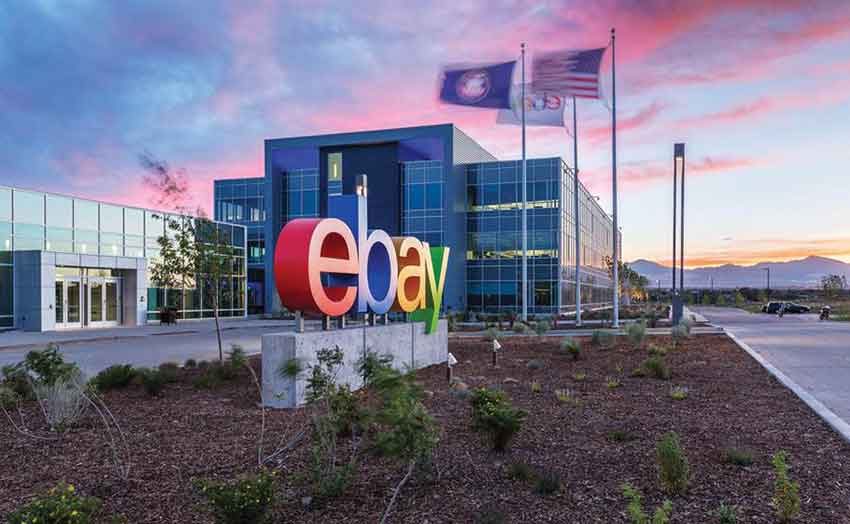
The eBay’s beloved red-blue-green-yellow logo is for many a symbol of the 1990s and for a good reason. It was one of the first successful dot-com bubble companies that epitomized online shopping. The company was founded in San Hose, California in 1995 and its most distinctive feature is the online auction feature, alongside a conventional buy-it-now shopping option.
With the revenue of almost $11B in 2023, eBay comes eleventh on the list of the largest eCommerce companies in the world.
Once a whole town was sold on eBay! It happened in 2012 when two Vietnamese buyers purchased the township of Buford in Wyoming for the sum of little under one million dollars.
eBay’s Market capitalization: $26.91 B (in 2024)
eBay’s Revenue: $10.11 B (in 2023)
eBay’s Number of employees: 12,300 (in 2023)

This Brazilian based online retail company is the largest of its kind in Latin America. B2W Companhia Digital holds a market share of 50%. It was founded in 2006 and is highly competitive, owning numerous shopping sites. B2W has recently announced a move into the US market.
With a revenue of over $2B, B2W Companhia Digital takes the first spot in South America on our list of the largest eCommerce companies.
B2W Digital’s brands Americanas.com, Submarino, Shoptime, SouBarato, Digital Finance, Submarino Finance and B2W Services boast a wide range of services, including, but not limited to: telesales, catalogs, TV, internet and newsstands distribution channels.
B2W Digital’s Market capitalization: $7.01 B (in 2024)
B2W Digital’s Revenue: $2.07 B (in 2021)
B2W Digital’s Number of employees: 5,100 (in 2023)

This American eCommerce marketplace launched in Chicago in 2008 reshaped the concept of group discount online shopping. It connects its subscribers to local businesses in one of 500 cities worldwide. The principle is simple: users get a discount and business owners increase the revenue; it’s a win-win situation.
In 2012, CBS created a sitcom about two guys working in Groupon called Friend Me. The show never aired and was canceled a year later.
Having listed all the companies, we can notice that they are evenly distributed geographically, covering every corner of the globe. Regardless of where you live, if you decide to purchase something online, you will inevitably come into contact with some of these enterprises.
Groupon’s Market capitalization: $0.61 B (in 2024)
Groupon’s Revenue: $0.51 B (in 2023)
Groupon’s Number of employees: 2,210 (in 2023)
If you mention outsourcing to an American or a UK company owner, they would immediately think of some distant Asian country. In reality, there is a region much closer to home, teeming with tech-savvy individuals where they can outsource their IT departments.

Like all the countries in the region, Serbia is presently experiencing its very own IT renaissance. Companies that employ young skillful workforce spring up across the country. The list of reasons why they are the ideal to outsource IT is quite long, but we’ve compiled a list naming the top ten advantages of Serbian IT sector:
A London based firm would hardly feel the +1 GMT hour difference in the time zone. American companies on the other hand, would experience an increase of workhours that coincide with Serbian time. These hours span more than half the US working hours.
In addition, Serbian companies have night shifts which guarantee an around the clock service. The money they invest in overnight work is less than the salary bonuses US companies pay their own staff.
Like we mentioned earlier, IT industry is on the rise in Serbia. The two hotspots are the national capital Belgrade, and the regional capital Novi Sad. Other cities such as Niš and Kragujevac are joining the club of Serbian IT hubs.
Not only are the local IT clusters receiving new members nearly every month, but the structure of the companies is convenient as well. They are highly versatile, ranging from shipping companies to online learning platforms. One can end up multi-outsourcing to Serbia.

Thanks to its socialist background, Serbian children receive excellent primary and secondary education. In technical sciences this culminates at university level. Both University of Belgrade and University of Novi Sad are ranked high in the Shanghai Ranking. This serves as proof that students receive excellent education at Serbian technical faculties.
In addition, the school system is under a trailblazing reform and it is now mandatory for schoolchildren to grasp the basics of programming early on. Children as young as nine years old get introduced to programming languages such as Python. This ensures that (outsourcing) Serbian IT companies will have enough skilled programmers in the decades to come.
The afore mentioned school system has one more ace up the sleeve. English is taught straight from the first grade and the age of seven. Many parents, aware of the importance of language skills, enroll their children into English classes in kindergarten and pre-school.
The result is a population in which nearly everyone can speak English, and to a high level as well. This is especially true in the case of programmers who all speak English fluently. The language barrier is virtually non-existent in Serbia.
What is more, a large number of people speak a third language in addition to their mother tongue and English.

Outsourcing in Serbia might not be that much “out” culture-wise. Namely, Serbia is a modern European country and its culture is similar to other continental cultures. This implies that work ethics are considerably high and more than acceptable for any Western franchise.
In short, this would be the m.o. of Serbian IT companies: deals are struck easily, quality does not suffer and deadlines are met.
If you choose to outsource in Serbia, we are sorry to say, your companies wouldn’t be the first. Many international companies have discovered this business oasis and have located their regional headquarters or R&D centers here.
To name just a few: Microsoft, Continental, Ubisoft, Sitel etc. All these multinational companies deemed Serbia as an excellent place to make their profit.
The whole reason behind outsourcing is to cut the operational costs. In this sense, Serbian IT sector acts as a best buy option. All the advantages listed above and below can be acquired at a reasonable cost.
It is definitely cheaper to outsource here that pay thousands of dollars, pounds or euros more than necessary in the country of origin.
The country still hasn’t formally entered the European Union, but the process is nearly over. This implies that the legislation is for the most part in accordance with EU laws.
Those who outsource to Serbia need not worry about the safety of their data. They are as protected by the local laws as they would be secure back home.
At some point, you will maybe have to physically visit the outsourcing company. A moment feared by most will soon turn into a surprise of a life time. Serbs are an outgoing people and they will gladly show you the fun side of their county.
There are literally communes of foreigners who visited the country once, fell in love with it and stayed permanently. The outsourcing choice provided them with a chance to change their lives for the best.
And isn’t it sweet to use your work as an excuse for pleasure.

Despite all the advantages, many Eastern European countries do have troublesome pasts, respectively. Serbia is no exception, but the county has definitely moved on. The safety of the outsourcing project is guaranteed by the country’s stable economy.
To sum it all up, Serbia is a real force on the outsourcing map of Europe and definitely worth the consideration. A highly skilled workforce employed by companies that offer affordable projects is a win-win situation for any company coming from the West.
eLearning platforms were abundant before most of the people discovered them prior to the coronavirus pandemic when online learning really took off. These platforms differ in many ways but they have one thing in common: they facilitate the need to learn new info without the need for direct contact.

As more and more schools and universities introduce online classes, even partially, officials are constantly searching for the eLearning platform that would suit their needs the best. At the same time, business owners are looking for innovative ways to train staff and hold meetings.
The needs of these two groups of people are similar enough that they can find what they are looking for from the pool of the best eLearning platforms. The 10 best eLearning platforms we are about to list have tens of millions of users combine, making them ideal both for universities and businesses alike.
Released in 2008, Docebo is a collaborative learning platform mostly use in formal learning. The facts that it’s fully customizable and easy to use, makes is popular among students, who use it to interact amongst themselves.
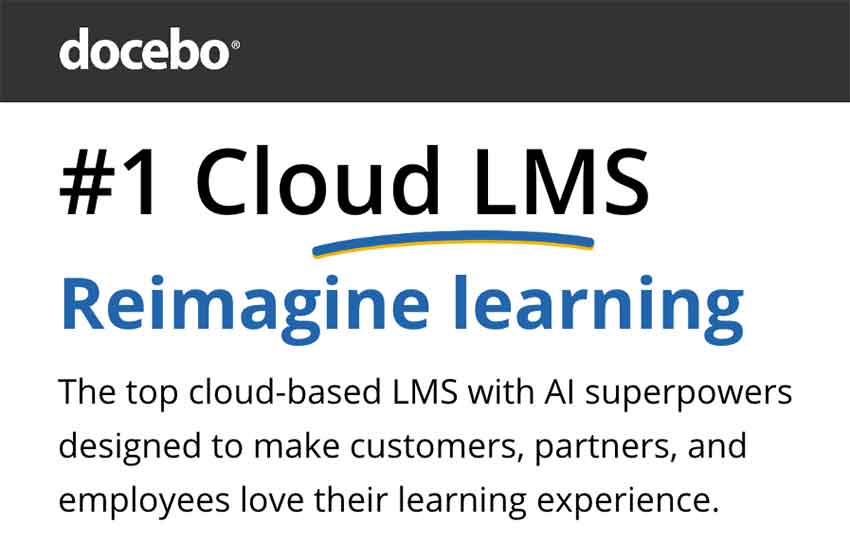
This learning management system (LMS) got its name from Latin, as its name is translated into English as: “I will teach.” Speaking of teachers, they get to assign extra informal and formal training sessions to students who need upgrading in certain areas.
Docebo is easy to navigate and it arrives with a wide range of integrations for third parties. Furthermore, users are able to centralize, organize, and manage online courses and easily track their certification process. As far as pricing is concerned, you need a quote from the developers to get a price plan.
A popular platform featuring gamification elements is Adobe Captivate. This comprehensive platform features highly useful automation tools, as well as 24/7 support, the standard for the industry. Although Captivate was released in 2019, Adobe had been experimenting with precursors of eLearning platforms since the early 2000s.
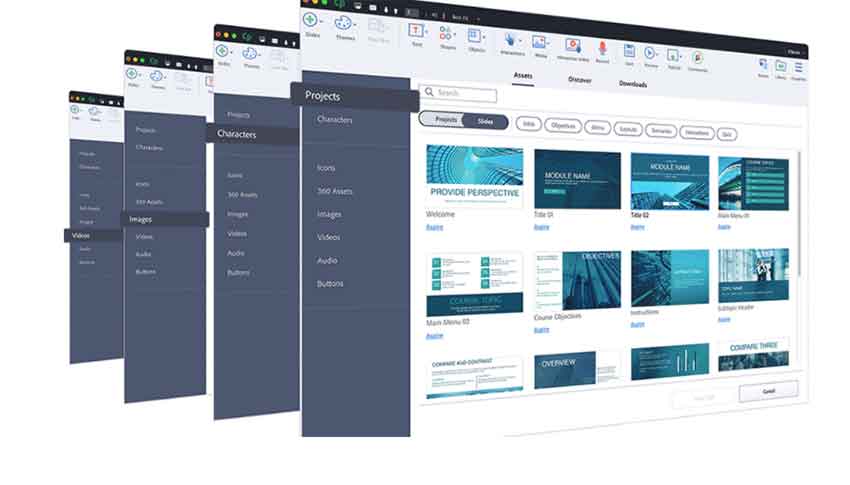
Adobe Captivate is actually an authoring tool used in educational learning and screencasting. In addition, this LMS by Adobe can be used for branch scenarios, software simulations, and software demonstrations, all in Shockwave Flash and HTML5 format. Users find converting Microsoft PowerPoint presentations to the abovementioned formats particularly convenient.
The software comes with a commercial license, so using Adobe Captivate Prime will cost you at least 4 dollars per month (for a single user). This is a small price to pay considering the fact that you can have a course up and running in less than an hour and a half. Such speed is possible thanks to the ability to auto-assign reports and learning plans.

One of the oldest free web services is Google Classroom. Launched back in 2014, the service was developed by Google with the main intention of easier file and assignments sharing between teachers and students, as the software’s name suggests.
This LMS features a completely free tier, as well as offering discounts for purchasing the pro tier. Part of the educational G Suite, Google Classroom comes with a variety of different tools that make it ideal for a school environment. From creating content to grading it, later on, this eLearning platform has it all.
Google Classroom comes with integrated Slides, Gmail, Calendar, Sheets, Docs, etc., which opens up several avenues of communication between teachers and students. Students are given a code to access lectures and they can access extra files in the Classroom.
On the other hand, teachers get an all-in-one eLearning platform that allows them to create, distribute, and mark assignments within one platform. This allows instructors to monitor pupils’ progress and keep track is someone is overdue with their work assignment.
iSpring Learn, like all iSpring products, was designed to be robust, yet easy to use. This learning management system (LMS) can fully automate most of your education management processes: monitor deadlines, send invites to students, notify them of new assignments, and more. It is customizable and offers gamification features like points, badges, and leaderboards. Some students have even said that taking courses with iSpring Learn felt like watching Netflix.
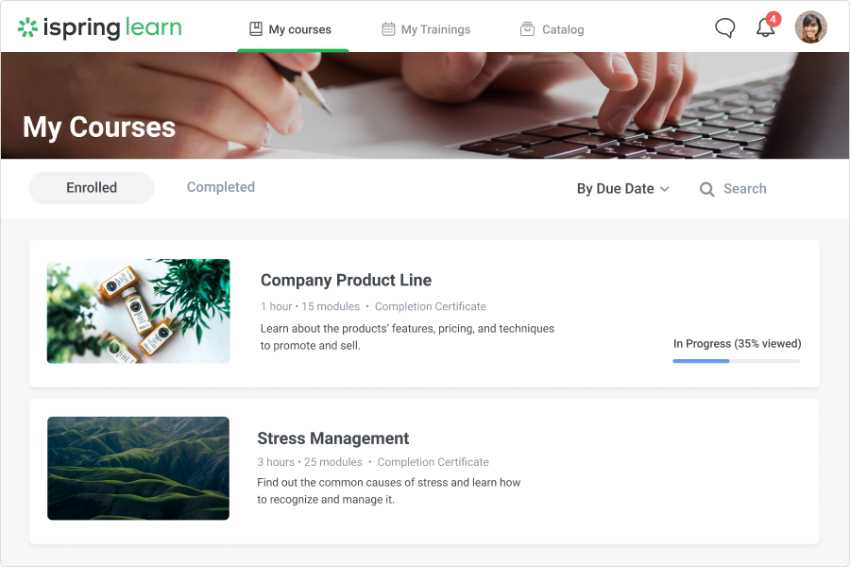
An advanced tracking engine generates student progress reports that show how many courses (or modules of a course) a student has completed, whether they passed or failed quizzes, what mistakes they made, and more. With this LMS, you can view analytical reports on a particular learner and an entire group, faculty, and university (or company), thus getting a more complete picture of your online learning.
Besides, a huge advantage of iSpring Learn is that it comes bundled with iSpring Suite. It’s an authoring tool with which you can create interactive online courses from scratch, convert existing PPT materials into online content, build engaging quizzes and tests, design interactive role-plays, record and edit video lectures, and more.
Pricing plans start from $2,82 per user/month. iSpring offers special discounts for educational organizations.
iSpring’s flagship tool iSpring Suite combines seven solutions in a single software. You can create online courses, quizzes, screencasts, video lectures, role-plays, ebooks, and interactions. And iSpring Suite works as a PowerPoint add-in, so if you know how to work in PowerPoint, you already know how to work with iSpring Suite.
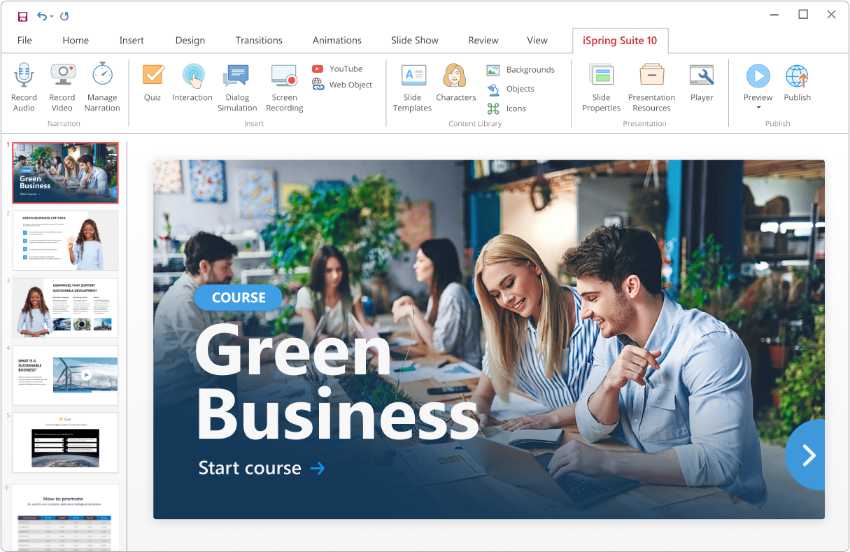
As easy and rapid as creating online learning content with iSpring Suite is, you can speed it up even more using Content Library and iSpring Space. Content Library contains over 89,000 eLearning assets: professional-looking templates tailored to educational purposes; characters of different ages, ethnicities, and professions; locations; and objects to enhance your courses.
iSpring Space is a cloud platform that is included in iSpring Suite’s advanced plan. With this tool, you can collaborate with your colleagues and students right in a browser, create simple courses and quizzes, leave feedback, and store your educational materials.
All content created with iSpring Suite can be uploaded to any LMS and will play perfectly on any device. Educational organizations can get iSpring Suite with a discount of up to 40%.
The next eLearning platform on our list is ideal for creating a myriad of different courses. Whether it’s the sheer number of themes you can choose from or catering for all screen sizes, Elucidat is a versatile eLearning platform. The developers’ goal was to create a web-based learning platform that would enable the easy production of business training materials.
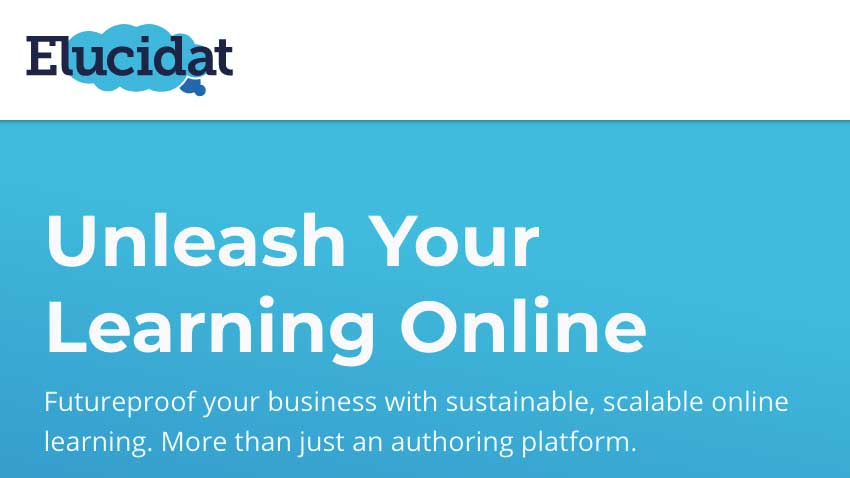
In order to facilitate the learning process, Elucidat features a page template editor, allowing you to select and tweak a theme to your business preferences. For savvy users, creating a theme using CSS or HTML is always an option, but Elucidat offers you to insert text, videos, and images using the drag-and-drop principle, familiar to everyone.
Essentially, you needn’t use lines of complying coding to end up with a visually appealing styling of your eLearning course. An additional perk of Elucidat is that you can manage hundreds of courses simultaneously, so it’s definitely worthwhile to ask their sales department for a free quote.
One of the oldest original authoring tools out there is Lectora Inspire. Like most of the eLearning platforms we list, Lectora Inspire functions across devices but is more complicated because you need to write basic scripts.

This web-based system comes with a review feature, making it an ideal tool for creating selling courses intended for customers. Of course, it can be used for employee training courses as well, since it boasts “how-to” resources.
Lectora Inspire’s biggest drawback would have to be its price. This commercial software is available for 2,600 dollars annually, a 10-courses limit included! The high price is somewhat justified because you get unlimited scripting, stock templates, free access to high-end graphics libraries, video editing, a screen template library, etc.
If you are looking for an LMS for education, then Blackboard Learn is definitely worth considering. Its primary users include schools, universities, as well as governments. The cloud-based data storage system ensures is responsive, mobile-friendly, and suitable for editing content from third-party providers.

These are the main reasons why students and teachers alike adore using it. The easy-to-use interface has made it popular among universities in the United States where it’s still ranked in the top 3 eLearning platforms.
Apart from teacher-student interaction and vice versa, Blackboard Learn is used for communication between respective departments and in staff training. Due to its popularity in the academic world, more and more businesses and governments are giving it a try.
However, the pricing is all but clear, so prospective users need to ask for a quote if they want to switch to Blackboard Learn. In addition, concerns have been raised regarding its GDPR compliance for use at European universities.
If you’re for a highly-responsive eLearning authoring tool, then Articulate 360 is the right way to go. This tool is mostly intended for pros, as it comes with an elaborate theme editor. Another advantage of Articulate 360, including extra apps, Rise 360 and Storyline 360, is the mobile-friendliness of every course you create.
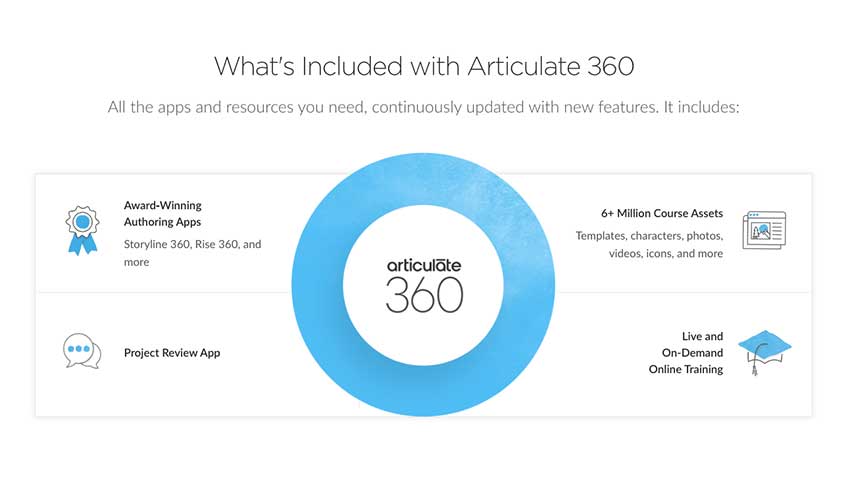
The ability to create visually interactive courses for every device imaginable (mobile ones are a priority), sets Articulate 360 apart from its competitors. There is no need for additional tweaking, as courses are instantly ready to be used on mobile devices.
For less experienced users, there is a library of themes to choose from, custom-tailored for specific users’ preferences and needs. All the edits you make regarding both text and images are stored inside a cloud, so the loss of data is virtually (pun intended) impossible.
Articulate 360 comes with a project review app through which you get help from educational experts in several languages, such as Chinese or Spanish. However, all these amenities build up the tool’s final price, as 1,600 is a lot to pay every year. Luckily, you have the option to start a free trial of this award-winning authoring app.
A subsidiary of LinkedIn, LinkedIn Learning is a website offering various video courses conducted by experts from all walks of life. The franchise was started back in 1995 as Lynda, only to be acquired by LinkedIn and later Microsoft in 2017.

This educational platform utilizes the format of video lessons to create a base of more 16,000 courses that are offered to LinkedIn users as a premium service.
Due to its longevity and the fact that such a renowned brand name as Microsoft stands behind it, LinkedIn Learning is highly valued in the B2B community. Its unique value is certification upon course completion. Furthermore, the course offers are personalized because of the data LinkedIn has on its user base.
The main audience for LinkedIn Learning are students who wish to gain extra knowledge on a particular subject. However, prospective learners need to conduct some research before enrolling because course descriptions aren’t necessarily clear enough.
There are monthly and annual subscription plans, the latter ranging around 300 dollars, making it fairly affordable in comparison to other eLearning platforms.
SHIFT is an easy eLearning option if you’re looking for a web-based authoring tool. If features both HTML and draft functionality, meaning that you needn’t possess any programming experience and still be able to produce a feature-packed e-courses.

The many templates SHIFT offers utilize HTML5, as well as Adobe Flash, enabling one-push publishing. Once you hit the “publish” button, the eLearning platform you created becomes compatible with a wide range of devices indiscriminate of their screen size or the aspect ratio.
Like with other authoring tools on our list, the subscription rate can pose a problem: 99 dollars per user per month or 999 dollars annually isn’t cheap. However, you do get a 30-day free trial, somewhat assuaging the high pricing of enterprise packages.
In terms of online marketplaces for educational courses, Udemy is among the most popular websites. Its user base in paralleled: some 50,000 instructors and nearly 40 million students. There is hardly a subject matter that isn’t on Udemy, as its creators enable easy course creation for anyone with enough expertise in a particular area of knowledge.

Apart from the online experience, learners receive materials in the form of a PowerPoint presentation, a PDF document, a Word file, or an instructional video. The secret behind the sheer number of courses is that there is no set-up fee for instructors but the platform does take a huge chunk of their revenue. Furthermore, instructors have no control over course pricing and discounting.
Perhaps the biggest downside of Udemy is the lack of communication between students and the instructor. This results in inconsistent quality of some courses, regardless of how well-rated they are and it spurs competition between course creators, which is not always a bad thing.
As you might have noticed from the 10 examples of the best eLearning platforms, the quality of e-courses is exceptionally high. The forte of each course is soon aped by others, increasing their respective profiles and improving the end user’s experience.
In terms of downsides to eLearning platforms, the cost of subscription takes the first place. Basically, if you want to go pro, then you need to splash some cash. Luckily, solopreneurs can find free authoring tools that will help them get started if nothing else.
In the time of the coronavirus when schools, universities, businesses, and governments alike are turning to eLearning platforms more than ever, choosing the right eLearning platform for your enterprise is essential.
Whether you’re an entrepreneur looking to hold an online training session or a university executive in search of the ideal eLearning platform for your students, you require a custom eLearning platform.
In our latest blog post you’ll get a unique chance to find out how all the career stages in programming look like, beginning with the apprenticeship programme, through the various engineering jobs to become the Principal Engineer of the company and finally conquer the entire industry. But be aware from the very start, not all programmers get to the final stage!
“If you are going through hell, keep going!”
A phrase attributed to Winston Churchill aptly describes the path a novice in the IT industry takes to become an Engineer of Distinction. This uphill struggle costs both money and time (measured in years), but the end result will hopefully prove worthy.
In this guide for software engineers and HR managers you’ll find useful information about all career stages in programming that all programmers have to come through.

We identified 9 programming career stages:
First, let’s find out how a Pre-Apprentice can become a full-fledged Software Engineer.

Having previously grasped the basics of programming, a programmer is now ready for his/her first post at an IT firm.
However, no one will instantly give them free rain, because they first have to undergo an apprenticeship programme. It typically lasts from two to four months and they get assigned to a mentor, who is usually someone of the Senior Engineers.
There are no ownership responsibilities yet and they will have to closely adhere to the programme designed by the firm and fulfill all of its requirements. Their mentor acts as sort of a “boss,” since the feedback they are provided with is essential to their advancement.
Basically, their only task at this point is to learn as much as possible before moving on to the next stage.
Congratulations!
If you become an apprentice, you get the official confirmation from the company that you know practically nothing.
Joking aside, the second stage of apprenticeship can last up to six months and although programmers still have to work under supervision, they do get some small tasks. Usually, they will be delegated with internal tasks in client projects and their work on these will be closely monitored by the mentor.
However, their primary goal still remains learning and self-development through observation and mentor feedback.
Having completed the apprenticeship, they are finally ready to become true Software Engineers. Now, your real programming career with all its stages can begin.
Although still considered a learning position, being a Software Engineer brings in a whole new set of responsibilities and opportunities for a young programmer. This is reflected in the minimum one year trainees are expected work in this role, but this can be prolonged up to three whole years.
Programmers not only get to work in a team, but they receive the same status as the people they are learning from. The process still involves accepting feedback graciously, since they are still focused on their own tasks which become more complex over time.
For those looking to broaden their horizons, this stage can also be an entry point into international careers. Software engineering skills are in demand worldwide, and this role can serve as a stepping stone to opportunities in different countries, exposing programmers to diverse work cultures and global project teams.
They now receive well-defined sub-tasks which they are expected to complete. Of course, close guidance and technical mentoring ensure that they don’t fall in danger of becoming stuck or blocked.
They still have to heavily rely on guidance, since they are not yet ready to learn in a self-directed way. At this stage, productivity skills are in focus, such as source control, editors, the build system and other tools, as well as testing best practices.
In essence, a Software Engineer is expected to acquire a broad knowledge of CS concepts, all the while focusing on growing as an engineer, learning existing tools, resources and processes.
Only after all these requirements have been met, regardless to the period elapsed, the programmer is ready to assume the role of an Advanced Software Engineer and for the first time co-own an area of projects.

So, the journey continues!
In the following paragraphs we will show you what a novice engineer must achieve in order to firstly become an Advanced Software Engineer and then a Senior Engineer.
The biggest advance in this position is the fact that a programmers’ world no longer revolves around themselves and their tasks, but they start focusing on their projects and peers. Yes, you read it correctly, their projects, since they tackle projects as a whole. They work from task to task, and actively seek guidance from others, since the danger of going down a rabbit hole still looms.
This position lasts from two, up to four years, which is one of the longer periods in the industry. No wonder, since advanced programmers are expected to learn how to write correct and clean code (with guidance), constantly staying in line with the stated best practices. In addition to that, they are expected to take part in technical design of features, as well as specialize in one or more areas (e.g. Ruby, Go, Javascript development).
Professionally, making the same mistake twice should by now have become a thing of the past, although the learning process is still ongoing. The programmer’s education is now self-directed and he does not rely on the feedback of senior engineers that much.
In essence, although an Advanced Software Engineer co-owns an area of project/product, he/she must still be eager to learn and ready to take initiative since those are crucial element in progressing to a Senior Engineer.
Now things really get serious. A Senior Engineer is in charge of a whole team and is responsible for projects with well-defined tasks. He is the go-to guy whom others approach for guidance. Taking initiative is therefore key to this role, since Senior Programmers have to understand and make design decisions and tradeoffs in their area.
Beside the technical issues, like not spending more time than necessary debugging, they also have to communicate with non-technical team members to give technical advice. Knowledge of industry trends, the company’s infrastructure and build system is also a must.
Since Senior Engineers possess a strong record of ownership of their projects, they are expected to contribute to common code because they have end-to-end responsibility. In addition, they are expected to identify problems and/or risks not only of their own work, but as well of others.
The leadership part of a Senior Engineer’s job is based on the ability to communicate. They should convey technical decisions through design docs, tech talks, blog posts etc. Apprenticeship programme is still important, but now a Senior Engineer assumes the role of a mentor to young programmers, pairing up with them and providing them with feedback and reviewing their design and code.
Senior Engineers have to mediate as well, bridging across various functions and departments, such as Product, Design, Analytics, etc. Communication-wise, their most important role is the aforementioned one of identifying problems both for their own and adjacent work, and discussing them in order to find the best solution as early as possible.
All in all, a Senior Engineer is the person whom everybody looks up to if a problem arises.
However, to be the best of the best and earn promotion, most Senior Engineers decide to take up some type of Tech Lead responsibilities. As an alternative, they can demonstrate a notable degree of people leadership by assuming mentorships, which indicates that they are ready to become Advanced Senior Engineers.
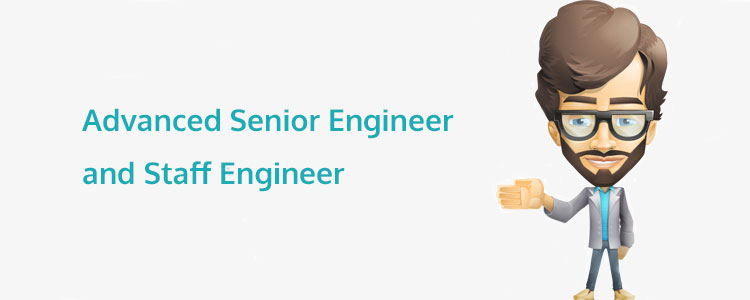
So, the next two stages in a programming career are Advanced Senior Engineer and Staff Engineer. Let’s examine what are the roles of an Advanced Senior Engineer and Staff Engineer.
It’s time for a company takeover!
Well not literally, but professionally, since the path from a Senior Engineer leads to the ownership of entire projects and even organizations.
In order to become a Staff Engineer, a programmer must first gain the title of an Advanced Senior Engineer and here are the necessary steps involved for both of these high-ranking posts.
After spending years as a Senior Engineer, it won’t be hard to spend roughly the same number of years as an Advanced Senior Engineer. Exact numbers vary, but one year is a minimum, and one can expect to work at this post for three years or even longer.
This is not without reason since these engineers exhibit not only ownership of the entire project/product, but take initiative to identify and solve important problems. They coordinate with others and set directions at project level, constantly taking part in the decision-making process.
At this stage, the issue of technical debt arises and has to be identified and tackled by Advanced Senior Engineers before it gets a chance to grow into a debt that requires up-front work to get involved.
When it comes to the work itself, excellent judgment is something that the programmer has attained so far. It is a much-needed skill since Advanced Senior Engineers act as a resource to unblock and enable the entire team. They are the go-to experts in the entire company for at least one of the areas (Rails, Ember, etc.).
Since they possess an understanding of the broad systemic architecture, they assume a new role of researching and even proposing new technologies, which will be essential in their next engineer career step.
Multi- is the keyword to the tasks a Staff Engineers undertakes. Like managing one project/product wasn’t enough, now multiple teams and projects are put in the care of this position. Since not many programmers advance this far in reaching these stages in their programming career, there is no fixed period one spends as a Staff Engineer.
Basically, they are expected to exhibit ownership across the organization. By now, these programmers have made an unambiguous impact on the entire company’s future technical path. Their role is crucial when it comes to developing long-term strategies for complete and critical areas of business.
All the tasks they had as Advanced Senior Engineers are multiplied so they act as a resource on several projects/products and across several teams as well. They not only research new solutions, but are responsible for their successful implementation. The improvements they create have to prove stable, scalable and in general perform well across major business-critical systems.
They have to recognize more complex problems, break them down and swiftly come up with solid solutions. Staff Engineers are masters of debugging and technical guidance since they are the highest instance their fellow programmers address.
Last but not least, Staff Programmers are regarded as the driving force for multiple teams. Their cross-team work consists of hearing and guiding debates in order to produce a decision which they will feel confident enough to back. They provide teams with clear directions for the period of six months or a full year and identify the areas which need most care and planning.
Both of the posts we discussed require the ability to look into the future, of the industry, all the while coordinating and guiding other programmers. This is no coincidence since the positions we write about in our final blog post have to assume responsibility for whole organizations and even the industry in its entirety.
Stay tuned, just two more steps left before we reach the programming crème de la crème.

The final piece of the puzzle! How to become Principal Engineer and an Engineer of Distinction.
Our blog post took us on path a programmer takes from as early as his apprenticeship days, across various Engineering posts, such as Senior and Software Engineers, all the way to a Staff Engineer, responsible for handling multiple projects and teams.
Not many people advance thus far, and even less become Principal Engineers, in charge of the entire organization. However, there is one more step on the road to programming stardom and that is the post of an Engineer of Distinction.
If you are talented, hard-working, and persistent enough (in that order) you might work as these engineers one day, so don’t miss this chance to find out what their work consists of.
You’re the man (or woman). No, literally, the whole company structure funnels upward to this post which is responsible for the whole organization. If there is a failure, he is likely to be blamed since it is up to the Principal Engineer to set the technical path and directions. He fully understands the impact of business decisions and choices and he is not afraid to make them.
The decision-making process involves not only envisioning things, but conferring these visions to others. A Principal Engineers is expected to anticipate challenges across the organization much prior to their actual occurrence and react by devising preventive measure and successfully executing them.
The facilitation of an internal discussion is crucial to this post, since achieving consensus from the entire team ensures that they all take the same professional direction. In this sense, a Principal Engineer inspires other engineers by directing their work in a way that has been commonly agreed on. He or she therefore serves both as a role-model and a mentor to every single member of the technical team, which lies at the heart of any IT company.
Make no mistake; a person suitable to become a Principal Engineer is hard to come by. The already established ones spend years and years at this post working for their respective companies. They possess a unique combination of unparalleled dedication to the craft and a fervent desire to progress from Staff Engineers. Since this is the case, it is even rarer to meet an Engineer of Distinction, the apex position of the entire industry and a dream of innumerous young programmers.
This is pretty much it.
This is the top of all stages in a programming career.
The skills of the few lucky ones who become Engineers of Distinction have outgrown the scopes of the biggest companies, and their reputation now spans the entire industry. They can truly be deemed as leaders, since they have made and constantly make breakthroughs and are in charge of projects which several organizations depend on.
Principal Engineers, whom we described as top-dogs, now seek guidance from Engineers of Distinction since not all organizations have the resources to employ them. Actually, very few IT firms have the capacity to sustain such an esteemed position, but if they do, they keep this individual for years on their team.
Work-wise, an Engineer of Distinction is also in charge of communicating multi-year technical strategy and taking the helm of the team. His main task is to identify the strategic areas in which further development will be directed in.
In the end, we notice that due to the enormous responsibility and workload both posts described entail, there are not many programmers that would qualify to fill in the shoes of Principal Engineers or Engineers of Distinction. As the industry grows, however, we could expect a rise in the number of these engineers, but mind you, this does not imply that the required skills level would go down, quite the contrary.
To sum up, a career in the IT industry is nothing to shy from, especially if one has the proper higher education for it. Each stage a programmers climbs up the imaginary ladder to success is a reward for mastering the craft. Therefore success in the programming profession is more of a journey than a destination in itself.
Now that you are familiar with all the career stages in programming, you are ready to become a Pre-Apprentice and perhaps go all the way, for as the famous Chinese philosopher Laozi once famously said:
“A journey of a thousand miles begins with a single step.”
“Digitalization” is the buzzword for doing business in the modern world. All enterprises want to become digital, there’s no question about it, but without fully understanding that the concept of digital transformation really means they are destined to fail. Large enterprises entering the digital future need to fully comprehend the term “digital” and everything it entails.

Perhaps the most important thing one must know about digitalization is its continuity, i.e. digitalization is a process. Digital transformation is based on the continual improvement of a company’s IT infrastructure, data, networks, and digital apps.
The business model of existing companies isn’t altered in any way to become “digital,” but rather mapped to accommodate the development of novel, digital products and services. For example, a clothes store remains a clothes store after digitalization but customers now have the extra option to order discounted apparel via an online shopping platform.
In a nutshell, digitalization is the fine fusion of online and offline business operations. Digital optimization and automation create room for individuality, flexibility, and general autonomy of products and services.
Although digitalization is a broad term, its application across different business sectors varies significantly.
In management, digitalization enables the reaction to market trends to be more flexible and quicker. If you wish to maintain a competitive edge, then digitalization is a must.
The same is true for the marketing industry since digital marketing became more popular than traditional marketing methods. From better ad targeting to personalized content, marketers welcome digitalization, as it makes their work a whole lot easier.
Salespeople are also having an easier time selling their products, as online shopping platforms made their wares available across the globe.
As a result, customer service improved across all sectors, not just sales. From web portals to faster support times, the overall quality of production has increased significantly.

Digital transformation affects the whole company but not every segment of its business is digitalized. As mentioned earlier, business activities such as marketing, human resources management, customer service, etc., are almost always digitalized.
In fact, the whole business model is transformed, including the value proposition, often considered the most “offline” section of any business. After rethinking its business model, a digital enterprise can count on novel sources of revenue.
In fact, the transformation could be so compelling, that the owners or the board of directors drop the traditional core business entirely. This is precisely what has been happening in the media market, with more and more newspapers and magazines opting for online-only editions.
Finally, company assets can become digital as well. We are not referring to real estate but rather tangible assets, such as information, intellectual property, and the customer base.
The common fallacy is that companies harvest the ideas of the entire staff when commencing the digital transformation. Although it helps to have employees with innovative suggestions and ideas, digitalization actually starts from the top.
In most cases, stakeholders are the initiators of the digitalization process but it doesn’t necessarily have to be so. Depending on the ownership structure, boards of directors, CEOs, or the chief digital offices can initiate the transformation as well.
As mentioned earlier, digitalization is a process that requires time to complete, making some enterprises reluctant to initiate it. Procrastination in the 21st century doesn’t end well, as companies who hesitate to go digital long enough, start losing the edge in the market.
The expectations customers have is based on a digital service offered by all industry players, so non-digital enterprises find it impossible to adapt quickly. Furthermore, staying “analog” leads to inefficiency interruptions in day-to-day business operations, and increased expenditure to upkeep an outdated infrastructure.
The European Union measures the digital competitiveness of its member states and publishes the annual digital economy and society index (DESI). According to the 2020 data, Denmark is still number one when it comes to digital performance, sharing 1st place with the Netherlands, but what does this title imply?

The digital transformation of an entire country and its society involves the digitalization of both businesses and public services. The five main dimensions of digitalization include:
The biggest advantage of becoming a digital hub, for instance for Copenhagen, is that it draws in companies from across the globe who want to jump on the digital bandwagon. A favorable “digital” business climate opens the way for tech startups to open and for cities to become “smart.”
Once owners of large enterprises fully understand what digital transformation entails, they can’t wait to initiate the process. However, it takes a lot of time and effort to digitalize a small business, let alone a multinational corporation.
From the firm decision to transform the company digitally to looking up the positive example of countries and companies alike, it is better to start digitalizing for the future, rather than remain in the analog past.
Did you know that the word “newsletter” dates back to the 1670s when it used to denote news reports that were disseminated in the epistolary form? Needless to say, the word soon fell out of use but newsletters made a grand comeback during the 1990s when they took a digital form.

Nowadays, newsletters seem to be on the sidelines when it comes to digital marketing strategies. This is because e-mails are no longer the primary form of business communication. The “more info in DM” types of messages on social media platforms took over the role e-mails had just a decade ago.
In this sense, newsletters are increasingly perceived as spam by shoppers, who are actively looking to decrease the number of newsletters they are signed up for. This is because newsletters contain a lot of information, much of which is totally irrelevant to individual shoppers.
Having realized that their newsletters were marketing duds, many companies cancelled them to devote their focus and energy to developing more efficient marketing tools that would actually boost sales. However, these marketers have failed to understand that folks didn’t really want to receive their newsletters, which ultimately led to their downfall.
So, it seems that the secret to a successful newsletter had been hiding in plain sight all the while: relevancy. The more general a newsletter, the greater the chances that the recipient will deem it as spam mail. On the other side, once a shopper or a business partner opens a newsletter and starts reading one news bulletin after the other, they are less likely to unsubscribe.
In order for a newsletter marketing campaign to succeed, marketers need to drop the company-centered worldview and start thinking from the shoppers’ perspective. Sure, it’s nice to share the news that a new office opened abroad but this would hardly be of interest to a local shopper. They would be more interested in coupons and discounts, to name just one example.
Before composing a newsletter, always think about what it is a potential customer wishes to read and be informed about. Apart from the aforementioned discounts (who doesn’t love those), they might be willing to read about new products or services, to read/watch a funny story, meme, or a video, or to simply read an educative text of interest to them (this is mainly intended for business partners).
Once you are able to produce topical, didactical, and newsletters that are generally fun to read, you can expect the sale numbers to gradually increase. This is more than great, as newsletters are scalable by nature, since they require minimum investment, yet guarantee maximum outreach.
For small businesses, a single employee well-versed in company matters can pen the whole newsletter, meaning that you spend minimum labor to compile a newsletter. E-mails are free to send and if you do your homework well, the newsletter will reach all of the potential customers who will find the content relevant and enjoyable to read.

Finally, you should make the effort to personalize the newsletter as much as possible. The tweaking doesn’t have to be done on an individual level, as you can place customers in broader categories. For instance, you can create slightly different newsletters for recipients coming from different socio-economic backgrounds, age groups, and sexes. This way, you further ensure that your emails are up-to-date, interesting, and relevant, so people actually read them all the way through.
The reason why personalized newsletters are important is the fact you display genuine care for customers and their shopping preferences. Once people notice that you have taken their shopping history into account when making new offers, they will be more inclined to select your brand or business over the competitors’.
However, personalization can be a double-edged sword when used improperly. Imagine sending a personal gift voucher for lingerie to a schoolchild! Such and similar blunders will cause shoppers to develop a disliking for your business, as you are clearly careless when it comes to their needs and wants.
Speaking of blunders in connection to newsletters, the timing of a newsletter can be a deal-breaker. In terms of frequency, you should aim for that sweet spot where you keep a person informed without boring them in the process. This is achieved by setting a timeline suitable for the industry you work in.
In general, once a week is the most frequent you should send out newsletters. On the other side, there are companies and organizations that send newsletters once in six months or even once a year but that period is too long when it comes to marketing purposes. Fervently wishing not to be boring, you can inadvertently cause customers to forget about your brand.
Although this is relative, we recommend monthly newsletters that offer the perfect balance between respecting other people’s time and keeping them updated. After all, the newsletter should play the card of FOMO.
Once you decide how often you wish to hit your subscribers with e-mails, it’s time to decide on the actual content of the newsletter. Firstly, you need to make the choice of how many topics you wish to cover. The logic is simple: the more frequent your e-mails are, the fewer the number of topics.
If you were to go by our recommendation of one e-mail per month, then your newsletter should feature three to four main topics. Depending on the art design of the newsletter, you could have major and minor topics, like on a news website. Of course, the focus would be on the main topics you wish to cover in the newsletter.
Secondly, you should understand that an e-mail is not a blog or a vlog in the sense that it is the news itself. In other words, try to include as little content as possible and focus on backlinks to pages where subscribers will get the full info. The textual content of a newsletter should be perceived as a blurb for a book, both in terms of content (catchy and informative) and length (concise; one or two paragraphs long).
Newsletters have the potential to reinvigorate any marketing strategy but you need to put some thought into their creation. From the letters’ font to the frequency of newsletters, every detail should serve the purpose of informing and entertaining customers. If you are successful, you’ll soon notice a steady increase in sales as the result of cost-effectively disseminating the latest info about your brand or company.
The marketing industry has come a long way from 19th-century black-and-white ads in newspapers. Today, ads and product pages have come alive, as shoppers have a chance to interact with them.
From videos at product pages, across ever more popular 360° views to the use of virtual and augmented reality, here are some of the best examples of companies which can boast interactive product pages.

On their own, videos are not suitable for a product page. They are more compatible with the main page but a short video or an animation can be used to enrich a picture gallery.
The following 3 examples show how retailers across the globe have been able to incorporate short videos to supplement product images.
The popular American retail chain of domestic merchandise is a typical example of how videos are implemented in a product page. A single video is inserted at the end of a picture gallery beneath the main product image.
A triangle inside of a circle is a clear indicator to visitors that they can play a video that will present the product in an interactive way. Moreover, you will find videos in galleries only for more complex products, such as blenders and charcoal grills, while items like curtains won’t have a product video because there is no real need for them.
Another world-famous brand from the United States is Target. Apart from a handy, pre-select zoom, website visitors can opt to play a short video from the strip on the left-hand side of the main product image.
Even product you wouldn’t normally consider interactive have come alive on Target’s product pages, such as a children’s desk lamp. The animation for this particular product is short (it lasts only 5 seconds) but it’s catchy and to the point.
When you google “garden accessories” in Australia, Hoselink pops right up. The company’s ambition is reflected in the fact that product pages feature explanatory videos supported by Vimeo.
Like on Target’s platform, the video can be selected from a strip on the left side of the product image, alongside a 360° view of the product. This way, even a retractable garden hose reel can be made fun for potential buyers, who are looking for a visual demonstration of the product they are interested in.
Unless a product page video is a stop-and-go animation, shooting such a video can be costly. Luckily, there is a money-saving alternative in the form of a 360° view.
This visual technique involves countless images that allow shoppers to create a 3D model of the product in their head. Depending on the industry, here are a couple of companies who have thrived on 360° views in product pages.
Ever since it teamed up with Renault in 1999, Dacia had been improving its car models. The Romanian car maker now offers the same type of virtual freedom in designing vehicles as its larger competitors.
Once the prospective customer choses an engine for his new Sandero, for instance, they are allowed to rotate the vehicle in all directions to see whether they like the selected color. Moreover, Dacia offers a 360° view of the car’s interior, helping the customer get a multidimensional feel of how their new ride will look like from all perspectives.

You can tell that the Italian luxury brand Bulgari takes pride in the watches and jewelry they make just by looking at how they have presented their products. Bellow a gallery featuring high-def, zoomable images, there is a 3D button that allows shoppers to look at a watch from every angle imaginable.
The option is easy to select and the 3D image is even easier to rotate using a computer mouse (there are brief instructions as soon as you click the 3D image). Of course, when shopping for a watch nothing beats trying a watch on but a 3D image helps shoppers determine which watches they wish to put on their hand in a store.
Unlike the previous two examples, Apple presents its products in a different three-dimensional way. Namely, when you open the product page for iPhone 12 there is no need to select a 3D view, as all you have to do is scroll down the page to discover the smartphone’s features and see it from various angles.
In this sense, the California-based tech giant is truly a leader in the market, as they have discovered a way to incorporate the 3D view inside the very essence a product page. In fact, a person wishing to find out more about the latest iPhone will see the phone from all the angles without ever realizing so!
Finally, we reach the apex of interactive product page design that is ultimately aimed at allowing shoppers to buy products online without having to visit brick-and-mortar stores to confirm their choice.
From sunglasses to furniture, here are top four examples of how virtual and/or augmented reality can instantly convert leads into sales.
Headquartered in Milan but founded in the United States, Ray-Ban has become synonymous with luxury eyewear nowadays. More importantly, they were among the first companies to incorporate augmented reality in their product pages.
The mechanism is rather simple, choose a model of glasses you like, click the “try them on” option, and after your camera turns on, you will see your face with the glasses on. This saves a lot of time for shoppers who can virtually try on hundreds of models in a matter of minutes, thus assuring they have selected the best-looking pair of glasses.

When Burberry launched its Olympia bag, the product page came with an interesting feature.
Namely, when shoppers click the “explore in AR” feature, they are provided with a QR code they should scan using their smartphone.
A statue of a Greek goddess comes to life and walks around their home with the preselected bag. The best thing about this surreal experience is the ability to take a snapshot or record a video to share with friends.
The world-famous technology and real estate franchise from Austin, Texas is one of the best examples of how real estate agencies can take buyers on virtual tours. Although they were popular in the past decade, virtual tours of houses and apartment really took off during the 2020 coronavirus pandemic.
Prospective buyers just need to select a property they are interested in and they are immediately “flown” inside it. Before their eyes a 2D blueprint of an apartment/house comes to life. Once you add the realtor’s advice and the image gallery, folks can now purchase a desirable piece of property without ever setting foot inside it!
Shopping for furniture is enjoyable for most homeowners but it involves a lot of preparation, namely, measuring. However, you can forget about the tape measure if you decide to furnish your home using Amazon’s augmented reality.
The Amazon app comes with a “view in your room” option that allows you see in virtual reality how a piece of furniture would fit inside your room. Apart from the scale, the feature is useful when it comes to pairing up the colors and materials with your room’s décor.
An interactive product page on a shopping platform is tenfold more likely to result in a sale than an item displayed on a store shelf. Shoppers have the opportunity to watch videos of the product in action, rotate them by 360° and ultimately, get a lifelike feel of inanimate objects through augmented reality.
Terms such as “user experience” and “user interaction” are buzzwords among marketers across the globe. However, there are still tens of thousands of web presentations that fall short of offering a satisfactory user experience, with poorly designed and written product pages that fail to convert leads into sales time after time.
Have you ever wondered why it is so?
When speaking of a typical product page, there are many elements of it, from visual appeal to product description and the listed price. We will not deal with the visual elements, such as HD product photographs, the size of the font, and interactive clothes size charts.

We wish to help you determine what it is that you should write for your product page, as this info is the real reason someone would open a product page in the first place. Not letting potential customers down lies at the heart of excellent user experience!
It may not appear as such, but the method a person uses to reach a particular product page will have an impact on the content. Two of the most popular ways potential shoppers discover a particular product are backlinking and browsing the web, i.e. googling.
Backlinking is beyond doubt one of the most popular ways of increasing traffic on product pages. In this case, a potential customer is offered a sentence or a paragraph on a third-party website, so they are really clicking into the unknown, no matter how well-formed the keywords are.
Such a visitor would want to read everything on the landing page, as they haven’t familiarized themselves with the product’s features beforehand. These visitors are more interested in the textual content, as they try to determine what it is your platform has to offer.
On the other hand, visitors who have googled the products they wish to buy or have opened a particular product page having browsed the website previously are more demanding. They are not interested in the general data about a particular product but are looking for specifications only content writing can provide them with.
For example, a person looking to buy a car won’t make the initial selection based on the color of the vehicle but they will open a particular product page, i.e. an ad to see the engine, body style, transmission, horsepower, etc. Only after they confirm that all of the above matches their preference will they take a look at the car’s color and the state of the body (e.g. rust issues).
Cars, like many other mass produced items, come in pre-set shapes that most shoppers are familiar with, so potential buyers are more interested in specific information about a particular model. This is where content writing comes into play.

When it comes to filling out the product’s name tittle, marketers’ suggestions are contradictory. Some argue that the name of the product should be kept simple, so visitors an easily spot it when observing a gridline view of multiple products. An example of a simple name for a product is “pillow,” “knife,” “T-shirt,” etc.
On the other side, many more marketers believe that the name of the product should contain as much keywords as possible. Of course, this doesn’t mean that you should describe the product in the title field but merely name it in such a way it contains all of the relevant information. Examples of long product names include “memory foam pillow,” “foldable single-edge knife,” “Blue men’s T-shirt,” etc.
The long name is somewhat better in terms of SEO but it’s hard to settle the debate once and for all since the product’s name goes hand in hand with the description of the product. The product’s name should contain primary keywords but it doesn’t have to be particularly long since product description can accommodate secondary keywords and provide visitors with extra information.
Apart from its direct link to the name of the product (no need to reiterate the primary keywords), product description is inherently connected to the image/video of the product. In this sense, the information that is visually available shouldn’t be repeated in the product’s description.
For example, if there are 30 images of a passenger car for sale and in 15 of them it is painfully obvious that the car is green in color, there is no need for the description to read: “green car.” The images speak a thousand words, as shoppers can see for themselves the shade of green (that would perhaps be hard to put into words).
The product description should, therefore, be regarded as an opportunity to add extra data to images. If we stick to the example of selling a car, things like engine power are impossible to know unless they are listed in the vehicle’s description.
The general rule for writing a good product description is to list all the data that shoppers cannot incur from pictures. Sure, it is tempting to praise a product and all of its features but this way you generate fluff and depreciate the product’s actual fortes.

For example, when describing a backpack, the following phrases are used: “large storage space,” “strong leader straps,” “suitable for carrying a laptop,” “lots of compartments,” etc. This and similar info is entirely or partially fluff and it will eventually prove too much for the person reading it.
We humans are visual learners, so describing an image is redundant when an HD photograph is already there. Like with the car, the ideal product description should contain only the information not visually obvious. “Large storage space” means little unless you specify the exact capacity of the backpack in liters (e.g. “cca 18l”).
Furthermore, a “laptop” is a pretty vague term, as the description should specify the size of the laptop (is it an 15.6-inch one or a 17-inch one, for example). There is no need to state that the straps are “strong,” but if they are made from leather or reinforced, then this data should definitely make it into the description.
Finally, a backpack can have as many storage compartments as possible but unless they are fully functional, then this data is irrelevant. Again, you have to specify what these compartments can be used for; from a mesh on the side that is ideal for water bottles to a luggage strap on the back (often concealed).
There is a reason why great graphic designers can earn big bucks online: presentation is everything and this is true for online eShopping platforms as well. Like with the length of the product title, there is more than one way to present textual data on a product page.
Some folks believe that product descriptions should consist of short paragraphs. This stance is perfectly OK for shorter descriptions, usually found on auction websites where individual users post their own products and describe them. In this sense, a product description resembles classified ads found in newspapers.
The tone of such a product description is definitely more personal, as it has a storytelling element to it but such descriptions are not suitable for large shopping platforms as they lack clarity and coherence that are necessary for fast browsing between multiple products.
If you were to open any product description page on Amazon or eBay, you will see they use bulleted lists. In fact, this is the dominant way product pages are organized today, albeit many platforms use categories instead of bullet points.
A bulleted list is ideal for listing product specifications, which is an SEO-friendly approach. However, the actual data you write under each bullet has to be relevant and fluff-free, as mentioned above. The total number of bullet points depends on a particular product’s features, so you can have as few as 2 points and as many as 10.
Writing content for a product page is often underappreciated, as business owners instruct marketer/content writers to simply copy the data from the packaging or the label.
As you have seen from the particularities listed above, a product page has its own structure in terms of textual content, so you have to take active care about the info you put on it.
The way you write and present content at a product page can make or break deal, which means that content writing is essential for a positive user experience.
Whether we are talking about social uprisings in Germany or the States led by anti-maskers or the worldwide travel ban that brought down thousands of airplanes, the COVID-19 pandemic really shook the world we live in. High unemployment rates and the rise of home delivery food options have made the news so far but another key issue is the fact that students have been out of school for months now. As fall approaches, schools and universities are having to come up with various ways to enable students to attend classes in an epidemiologically safe manner. For this reason, many schools are turning to eLearning platforms, as a possible solution, whether interim or permanent.

From first-graders to seniors at college, more and more people are logging in eLearning platforms and taking classes online; something they have never done before. The challenge is even greater for seasoned teachers and instructors who preferred tête-à-tête during the decades they worked in education.
The eLearning hype is not restricted to educational institutionally exclusively. After the introduction of #stay_at_home orders by national and local governments, many businesses turned to work from home only. This switch includes training sessions as well since they are now carried out online using eLearning platforms.
These tectonic shifts in the way we lead our lives direct us at answering a seemingly simple question:
What exactly are eLearning platforms?
In a nutshell, it’s an online portal/platform containing educational content.

An alternative definition includes the addition of live instruction regarding a particular topic. Some learning platforms allow access free of charge (such as amateur YouTube channels), while others ask you to pay a membership to be able to attend lectures.
The 2020 coronavirus pandemic might have given rise to the popularity of eLearning platforms but this is not the main reason why schools and businesses alike are using them to replace traditional learning formats in the long run.
Most obviously, you needn’t leave your house to attend a class online. Of course, there are disadvantages to working from home but you still get to save gas money, if nothing else. Furthermore, the atmosphere is more relaxed, so you can time the learning process to your preferences.
For children willing to learn, this means that they will no longer get distracted by their less attentive peers. The teacher can simply lock them out of the conversation or they can leave the video call on their own. In fact, using eLearning platforms is associated with various issues that can be attributed to different types of eLearning platforms.
Additionally, eLearning platforms offer various tools for collaboration and communication. Every experienced e-learning designer can tell you that, with the right set of tools, you can foster greater engagement, increase student participation, and facilitate knowledge acquisition. For instance, the most common tools are virtual whiteboards, where students and instructors can work together in real time. Such tools enable attendees to ask questions without fear of being judged by their peers or instructors, thus paving the way for a more engaging learning experience. Another major advantage of eLearning platforms is that you have access to a vast amount of resources and learning materials online. The educators working at https://ntponlinelearning.co.uk can explain how easy it is for students to access materials such as videos, presentations, and other forms of interactive content through eLearning platforms. This makes the learning process more interesting and engaging, which can lead to better retention of knowledge.
The most common type of eLearning platform that predates the Internet itself are asynchronous courses. These courses can be both online and offline (in which case you download or burn materials) but the former method is more popular nowadays because of ever-increasing Internet access speeds.
These courses are not held in real-time, as students acquire content beforehand and they are given an exact timeframe for completing individual courses, as well as the entire course. Communication between lecturers and students mostly takes place through discussion boards and e-mail correspondence.
Advanced courses even have business communication platforms, such as Slack, to facilitate better and faster correspondence. Essentially, asynchronous online learning environments are ideal for students who have a busy schedule that prevents them from attending scheduled online classes.
Although their popularity was on the rise in the 21st century, online instruction courses really took off thanks to the COVID-19 pandemic. A lot more people were literally forced to learn from home, so teachers and instructors saw a sharp increase in the total number of lessons.
Online courses are fairly simple to understand, as they involve a lecturer teaching simultaneously all or some of the students. In some instances, students can ask for 1-on-1 classes. Classes are held via widely available video chat and messaging apps such as Skype or Zoom, although some companies and institutions have decided to build their own eLearning platforms.
Synchronous online courses aren’t used exclusively for learning, as the tech behind them allows for webinars and even fairs to take place in real-time, with thousands of participants tuning in to watch. The biggest advantage of this type of course is the ability to participate in a curriculum-based course that is not much different from ex-cathedra lectures, typical of the university environment.
Offline schools have one big drawback and that’s parents’ negative involvement in their children’s schooling. However, eLearning platforms not only limit the parents’ role but they clearly define it.

The fact that the teacher is “virtual,” allows parents to send their suggestions and complaints through a messaging app. If there is a need for face-to-face communication, parents can always schedule a video call.
Your child’s reports are sent using the same com channel, as you can even edit them or write your opinion in the form of a comment. Finally, eLearning platforms allow parents to stay up to date regarding their children’s homework and check it online. In addition, they can edit it and make suggestions before the teacher is granted permission access to the file.
The reason why parents’ role is reduced to a mere supervisor and not a co-.teacher, as in offline education, is the personalized experience eLearning platforms offer. This is especially true for asynchronous courses where children are left to move at their own pace.
From understanding content stored 24/7 at an eLearning platform to loosely following directions from the instructors, children are left to cover ground when and how they see fit. Such a high level of independence is typical of adults, so companies use such platforms for educational purposes in the era of working from home.
It could be argued that eLearning platforms allow for exploration on side of the learners. This is ideal for creative industries, where business owners depend on the savviness of their employees to create extra value that would separate them from the competition.
Due to the global lockdown, entrepreneurs were worried about the levels of ingenuity going down but the aforementioned independence in the realm of eLearning platforms makes it possible for workers to stay sharp-minded and creative.
The future of the online learning boom in a postcoronavirus world is a question on the minds of many. Although major shifts are possible and even expected, one thing is certain: eLearning platforms are here to stay.

One reason why the eLearning industry is likely to increase are Internet connection speeds worldwide. More and more people can now make video calls, so instructors won’t run pout of students any time soon. Furthermore, mobile devices can now facilitate eLearning apps, making it possible to learn on the go.
In the future, eLearning platforms are likely to experience gamification, i.e. the introduction of playful methods to engage users and enhance the learning process. As stated above, the learning experience is going to get increasingly personalized, with teaching materials custom-tailored to match the preferences of each student.
Regardless whether your business is a thriving IT startup or you just run a small local business, you feel the need to make your presence felt online. Having a website or even trading online is a must today. However, merely having a web business is far from enough: you must improve it constantly, and here is a list of the first five things you can do to make your website better:

Obviously, all websites have objectives their owners want them to complete, but the really successful ones are those with clearly defined achievable goals. These depend on the type of business you run. If you are a store, then naturally you want to sell as much products as possible online, and e-commerce should be your priority.
If you run a blog, then advertising might be a good funding opportunity, but your primary goal should be grabbing the attention of the biggest number of people and grasping their attention for the longest period possible.
From your point of view, the WHY is more important than the HOW, the web development company will take care of the latter. Knowing precisely what your goals are, presents the first and the biggest step in achieving them.
And if you need professional help, be sure to check out this web design and marketing company.

What good are a great product and an excellent website to you if they are on page fifteen of Google search?
Since it is highly unlikely anyone would browse that far, you have to be aware of search engine optimization that can increase your number of customers in the long run. The solution is similar to defining your goals: use keywords that are relevant to your web business, don’t dissipate the content on your web page, use meta tags etc. Maybe you should consider hiring the pro or a SEO agency because this can be tricky.

Since you are bound to have images and audio content, and the more the better, there is an issue of how to upload it. It should be compressed enough in order not to slow down the web presentation too much. A technical issue, but still an important one. Don’t forget to name photos you are using since they can appear in Google image search.
Having a link to a social network on your website is not a novelty, and you should implement this. But have you ever given a thought on which networks you associate your website with?
The common fallacy is that you should have as many as possible, so companies create profiles on networks nobody uses. Imagine how displeasing to the eye is an official Instagram profile with only one picture posted six months ago.
Right from the very start, opt for 2, 3, or as many social networks as you like. Just don’t forget to post all the time on them. This acts as your secondary web presentation, don’t neglect it.
Customers are constantly worried about their confidential information when entering them online on any webpage. By securing your website and especially its payment page (where users will be required to enter their information) with SSL certificate & enabling a trusted site seal on the website or web pages (usually comes free with SSL), you will improve users’ trust in your business. This move will help improve sales on the website as well as your business reputation.

The final piece of advice for your web business is to take an active role in your web development. If you yourself are the web developer, excellent! If not, be sure to unambiguously tell the web development company what your primary goals are.